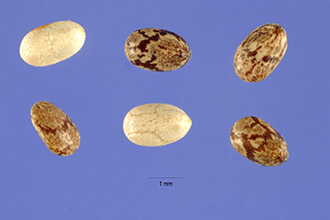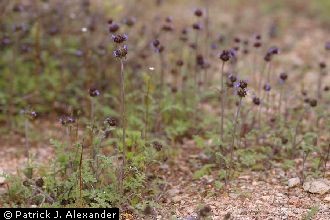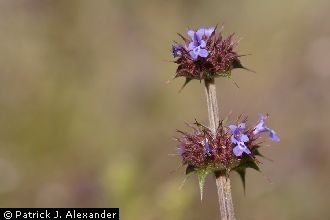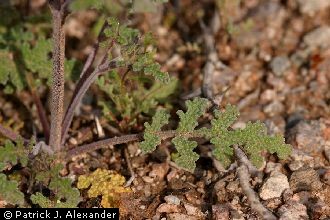Chia
Scientific Name: Salvia columbariae Benth.

| General Information | |
|---|---|
| Usda Symbol | SACO6 |
| Group | Dicot |
| Life Cycle | Annual |
| Growth Habits | Forb/herb |
| Native Locations | SACO6 |
Plant Guide
Alternate Names
Sage
Uses
Ethnobotanic: Chia, the Spanish name for Salvia columbariae, is a plant of great economic importance to many Native American tribes in California, who have long used chia for food and medicinal purposes. Historically, chia seeds were a staple food for many Pacific coast groups including the Salinan, Costanoan and Chumash as well as inland tribes such as the Paiute, Maidu, and Kawaiisu. Chia is one of the first plants obtained by humans in Kawaiisu mythology (Zigmond 1981). Chia was regularly cultivated along with corn in the fields of the Nahua peoples of ancient Mexico. Salvia columbariae seeds were used by the Chumash on Santa Rosa Island, one of the Channel Islands off the coast of Southern California, as long as 600 years ago, as evidenced by radio carbon dating of seeds found in pottery jars at burial sites there (Clebsch 1997). Large beds of chia plants are reported to bloom in areas that once were the locations of ancient Native American villages (Romero 1954). Chia is an important resource that was often managed by native peoples. The Chumash and Cahuilla were among those groups who would increase the following year’s harvest by periodically burning stands of chia plants (Timbrook et al. 1982;Bean & Saubel 1972). Chia seeds are a valuable source of nutrients, protein and oil. When roasted, they have a pleasant, nutlike flavor. The Diegueño took chia seeds on journeys where a few seeds kept in the mouth and periodically chewed, would keep up their strength (Hedges & Beresford 1986). One tablespoon of chia seed is said to be enough to supply a person with 24 hours worth of energy. © Charles Webber California Academy of Sciences@ Calflora The seeds were usually harvested by bending the stalks over a seed burden or gathering basket and beating the seeds out of the prickly, dry heads with a seedbeater. Even though the seeds are tiny, in this way, several quarts could be gathered within a few hours. The Cahuilla tribe of southern California would harvest the entire stalk and tie them into bundles (Romero 1954). The bundles were then taken to a specially prepared clear, hard area of ground where the seeds were separated by thrashing the stalks with sticks and bare feet. Baskets were used to fan away the chaff, leaving the seeds to be gathered. After hulling and winnowing, the seeds were stored underground for later use or were often parched with hot coals or pebbles in baskets or clay trays. The seeds were pulverized in a bedrock mortar into a meal that was used to make biscuits, cakes, and a mush called pinole. A porridge or soup was made by mixing the ground seeds with water and then cooking in a specially made watertight basket to which hot rock or stones were added. Upon the arrival of wheat with the Europeans, the Cahuilla and other native peoples continued to grind chia along with the wheat berries (Barrow 1978). Mason (1912) writes that the Salinan mixed chia with flour to make “tortillas, delicate and agreeable to the taste as if they had kneaded them with lard.” The Diegueño would “improve the flavor” of a large quantity of wheat by adding only a small amount of chia (Hedges & Beresford 1985). Chia seeds contain a musilagenous substance and expand considerably into a gelatinous volume when moistened. An aromatic, minty beverage could be made by soaking raw chia seeds in water (Saunders 1923). Ground seeds were soaked in water to make a refreshing beverage that is said to have high thirst-quenching properties. Chia, used in this way, is also said to make the alkaline water of the desert palatable. Seeds mixed with water were also used to treat fevers (Bocek 1984). A hot poultice of ground chia seeds was placed inside a cloth or bandage and applied to infected areas of the body. Europeans quickly adapted medicinal uses of chia; early California mission fathers learned how to make an infusion from chia seeds to treat fevers and it is said that chia makes the “finest poultice for gunshot wounds” (Jepson 1911). The Costanoan were among the many tribes who used chia seeds to remove foreign matter or reduce irritation of the eye (Bocek 1984). A single to several of the whole seeds were dropped into the eye, and rolled around or left in overnight. The Cahuilla tribe used chia seeds in this fashion to remove sand in the eyes acquired from sandstorms encountered after a long day of hunting (Romero 1954). Seeds were sometimes mashed with a rock or hammer and placed in the eye overnight (Zigmond 1981). The film that resulted from the gelatinous seeds in either method absorbed any foreign body or irritant and helped to ease inflammation. Chia seeds were often used for ceremonial offerings (Timbrook 1990). Other: Chia is one of the traditional foods that is considered useful by researchers in treating diabetes, a disease that afflicts many modern Native Americans and may be attributed to the loss of many traditional foods (Lowry 1999). Wildlife: Chia flowers are an important source of nectar for bees and butterflies. Many species of birds, small mammals, and insects eat the seeds.
Status
Please consult the PLANTS Web site and your State Department of Natural Resources for this plant’s current status (e.g. threatened or endangered species, state noxious status, and wetland indicator values).
Description
General: Mint family (Lamiaceae). Chia is native to western North America. The plants can vary greatly in size depending on moisture availability ranging, in both height and diameter, from 3 to 4 cm under very dry conditions to 60 cm under optimal conditions. The thick, wrinkled leaves (10 to 15 cm long) are dark green and deeply lobed with a thin covering of fine, soft, grayish hairs on the upper surface. Leaves grow predominantly from the basal area of the plant with smaller leaves growing up the stems. Several stems emerge from the base of the plant, each bearing from one to four interrupted (2 to 3 cm apart) button-like whorls of tiny, tubular flowers (6-16mm). The pale blue to deep blue flowers have two lips; the white-tipped lower lip is cleft into three lobes, with the central lobe slightly larger in size. Several contrasting leafy, burgundy-colored bracts subtend the flower heads. A spiny tip protrudes from a central notch in each bract. Each flower results in up to 13 tiny, gray to light brown, flat seeds 1.5-2mm in length. Flowers bloom in late spring or early summer, from March through June in California. As the season progresses, the blossoms dry and turn from clear blue to golden, and remain dry upon their stems. The tiny seeds disperse by shaking out of the dry blossoms. Distribution: Chia’s native range extends through the coastal and inner coast ranges of California from Mendocino County in the north to Baja in the south. Chia grows throughout southern California and into adjacent areas of Nevada, Arizona, Utah, and Northwestern Mexico. Chia was once more common in many of its native areas, but its populations have declined due to overgrazing, urban development, and fire suppression (Timbrook et al. 1982). For current distribution, please consult the Plant Profile page for this species on the PLANTS Web site. Habitat: Chia is a member of the foothill woodland, coastal sage scrub and chaparral communities in California, where it sometimes forms extensive stands (Bean & Saubel 1972). It can be found in the open, exposed grassy areas of woodlands, in sandy washes, dry, open plains, hillsides and gravelly, disturbed sites. It is commonly found at elevations below 1200 meters but is known to grow in some areas up to 2100 meters (Munz & Keck 1963).
Adaptation
Chia is adapted to arid conditions and soils of low fertility. It is one of the so-called “fire following” species, in that it increases in abundance after a fire (Timbrook et al. 1982).
Establishment
Annual wild flowers, such as chia, are generally planted directly into a prepared bed or border area, Chia requires full sun, good drainage and only enough water to become established, Do not plant chia near lawns and other plants that require frequent watering, Seeds may benefit from pretreatment, but this treatment may vary depending on the origin of the seeds (Emery 1998), Ask your seed supplier as to their recommendations, Broadcast the chia seeds in autumn by sprinkling the seeds onto the surface of the soil, Rake the seeds lightly into the soil, A light sprinkling of charate (the charred remains of burned plants) over the sown seedbed has been shown to increase germination (Emery 1988), Use soil moisture sensors to measure the soil moisture of Chia., Once established, Chia is quite drought tolerant, The plants will tolerate some moisture during the growing period but should not be watered frequently, Remove weeds as they appear, If necessary, seeds may be planted in flats in the early spring and then transplanted later into a sunny, open area, Fill flats with a light, porous soil, Appropriate soils may be purchased or a homemade combination of equal portions of compost, garden loam and sand may be used, Sprinkle the seeds evenly over the surface, Cover with a fine layer of more soil not exceeding two times the diameter of the seed, Lightly press the surface to insure contact of the seeds with surrounding soil, Use a fine spray nozzle to gently water the flats, Keep the flats evenly moist and do not let them dry out, Reduce watering frequency after the seedlings emerge,
Management
Chia will self-sow freely if the seeds survive predation by birds, mice and ants. Several bee species have been observed pollinating chia, however it also has the ability to self-pollinate in the absence of these insect visitors (Visco & Capon 1970). Chia hybridizes freely with other Salvia species, including perennial shrubs, such as S. mellifera (Clebsch 1997). Cultivars, Improved and Selected Materials (and area of origin) Contact your local Natural Resources
Conservation
Service (formerly Soil Conservation Service) office for more information. Look in the phone book under ”United States Government.” The Natural Resources Conservation Service will be listed under the subheading “Department of Agriculture.”



